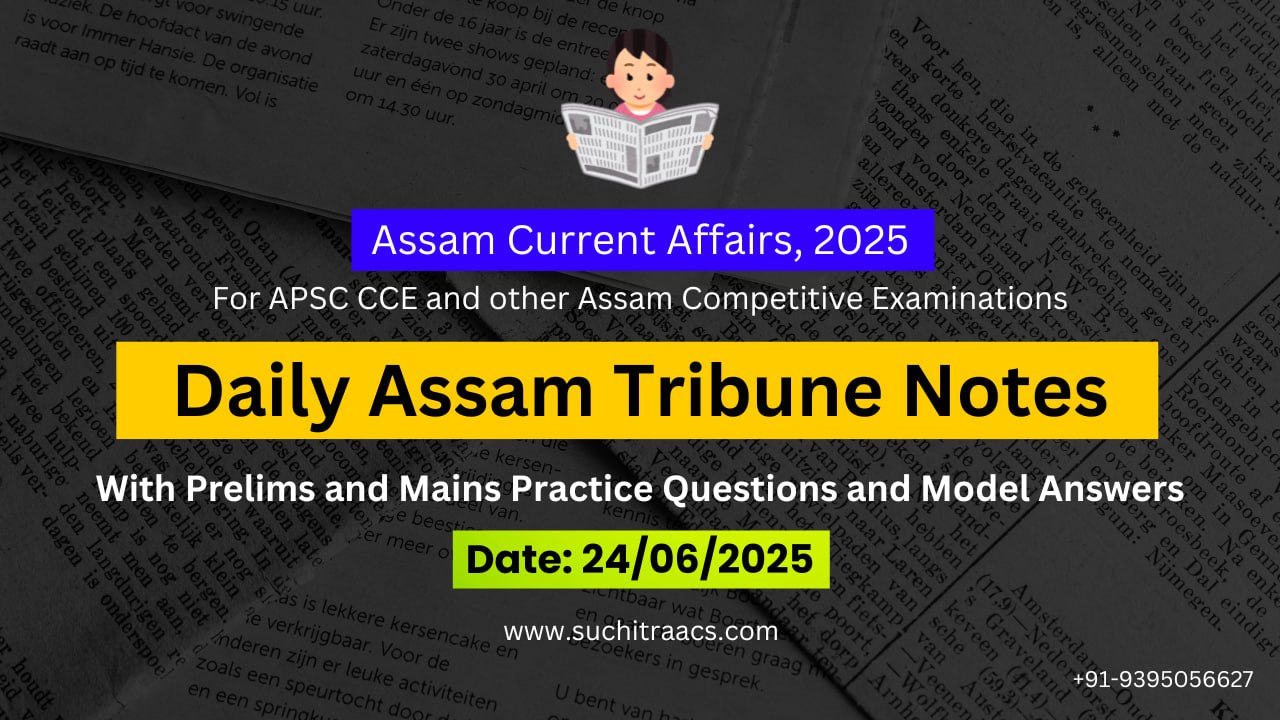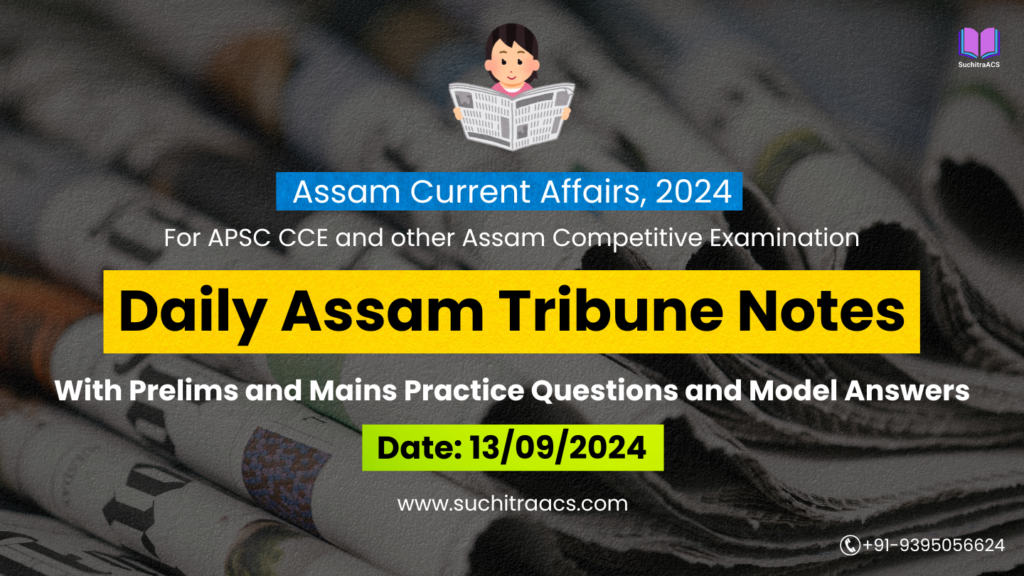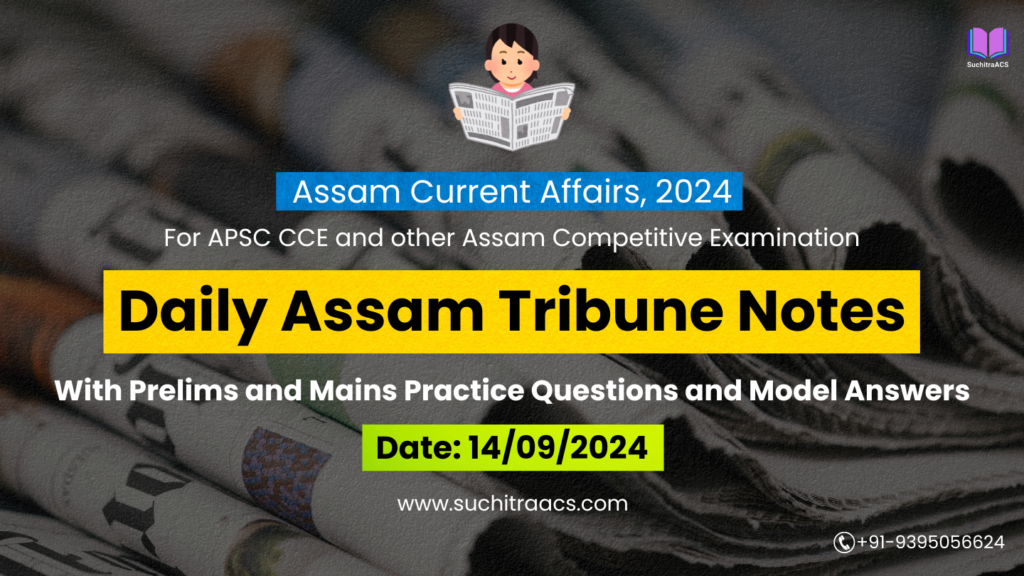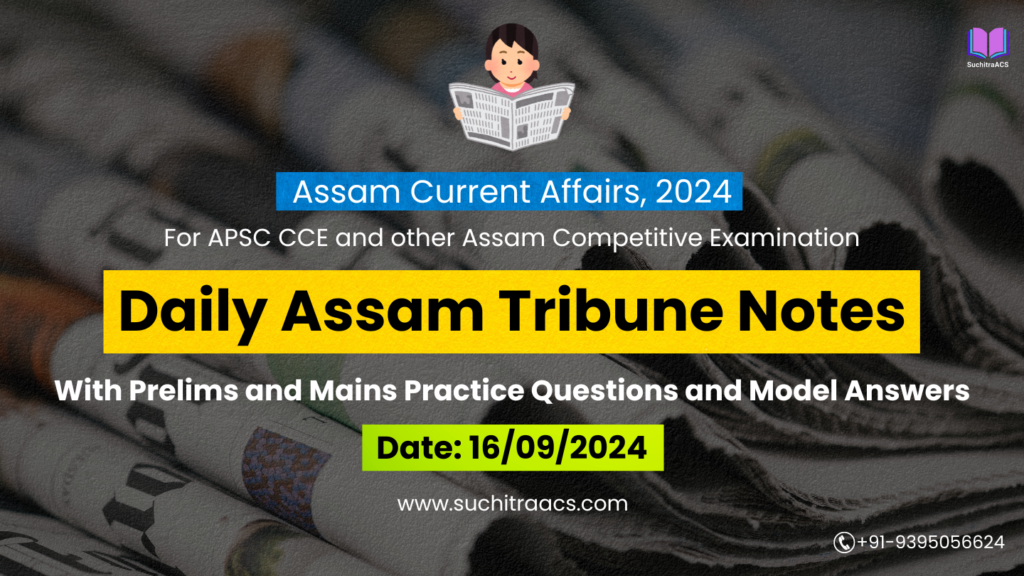APSC Current Affairs: Assam Tribune Notes with MCQs and Answer Writing (24/06/2025)
For APSC CCE and other Assam Competitive examinations aspirants, staying updated with current affairs is vital. This blog covers most important topics from the Assam Tribune today (24-06-2025). These issues are key for both APSC Prelims and Mains preparation, offering insights into the APSC CCE Syllabus.
✨ APSC CCE Online Coaching, 2026
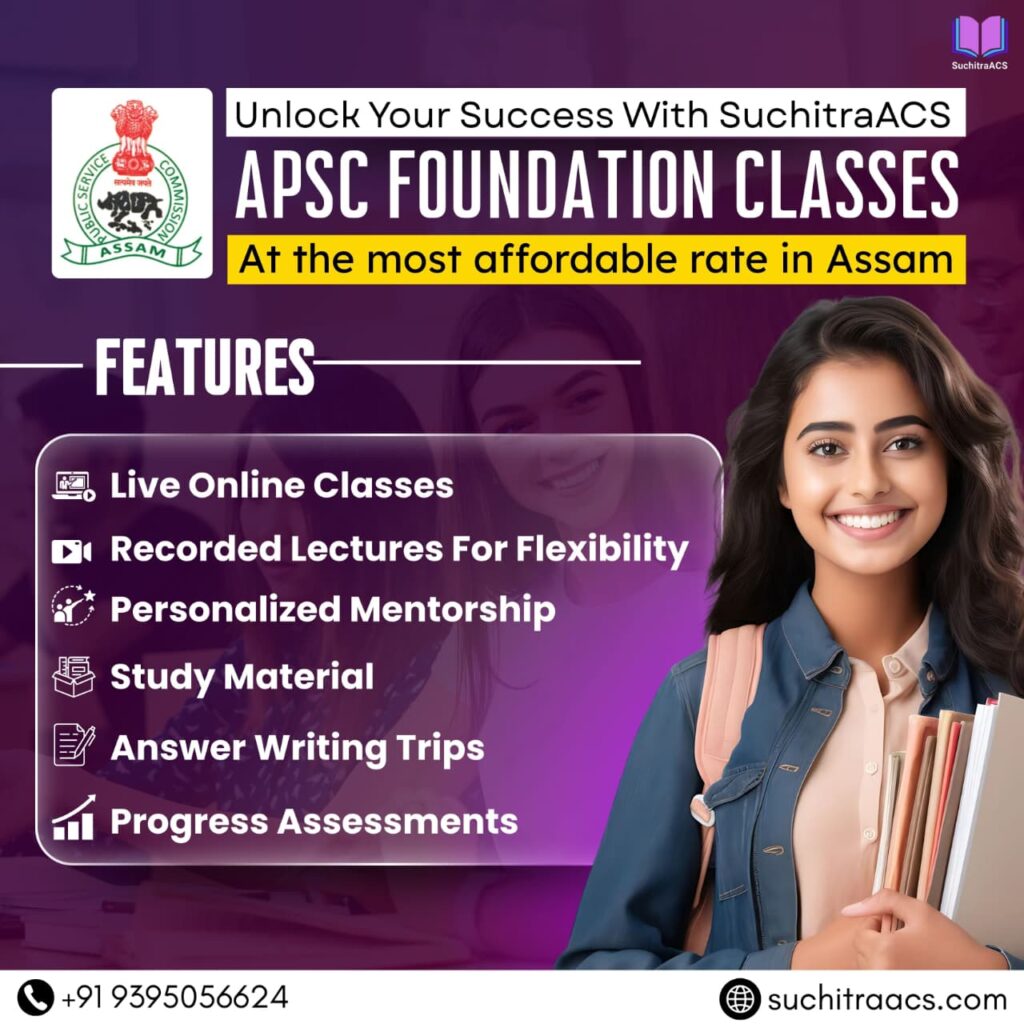
🌡️ Asia Warming Twice as Fast as Global Average: WMO Report
📘 GS Paper 1: Geography – Climate Change | Glaciology
📘 GS Paper 3: Environment – Disaster Management | Water Security | Ecology
📘 APSC GS Paper 5: Assam’s Ecological Vulnerability | Himalayas & Climate Change
🔹 Introduction
According to the World Meteorological Organization’s (WMO) State of the Climate in Asia 2024 report, Asia is warming nearly twice as fast as the global average. This rise in temperature is triggering cascading effects – glacier melt, rising sea levels, heatwaves, and extreme weather events, threatening livelihoods, biodiversity, and water security across Asia, including Assam and the Eastern Himalayan region.
🔑 Key Highlights from the Report
| Climate Indicator | Observation |
| 🌡️ Avg. Temperature (2024) | ~1.04°C above 1991–2020 avg. in Asia |
| 🌍 Warming Rate | Almost double the global average |
| ❄️ Glacier Loss | 23 of 24 glaciers in Central Himalayas and Tian Shan lost mass |
| 🌊 Sea Level Rise | Faster than global average on both Pacific & Indian Ocean coasts |
| 🧊 Snowfall Reduction | Sharp decline in winter snowfall |
| 💧 Heat-Related Casualties | 48,000 heatstroke cases and 159 deaths in India in 2024 |
| 🌪️ Climate Extremes | Heatwaves, glacial lake floods, cyclones, and droughts across Asia |
🧠 Prelims Pointers
WMO: UN specialized agency on weather, climate, and water
Glacial Lake Outburst Flood (GLOF): Sudden release of water from a glacial lake due to melting/glacial dam breach
Tian Shan & Central Himalayas: Two major glacial systems facing intense melt
Cryosphere: The frozen water part of the Earth’s system (glaciers, snow, permafrost)
SDG 13: Climate Action – mandates resilience and adaptation measures
📝 Mains Pointers
A. Why Asia’s Climate Crisis Matters
Home to 60% of the global population
Dense settlements, agriculture, and river-dependent economies
Himalayan glacial melt impacts major rivers: Brahmaputra, Ganges, Mekong, Indus
Coastal mega-cities (e.g., Mumbai, Dhaka, Jakarta) highly exposed to sea-level rise
B. India-Specific & Assam-Specific Concerns
| Concern | Impact |
| 🌡️ Assam’s Heat Stress | Rising urban heat in Guwahati and Barak valley |
| 💦 Brahmaputra Basin | Increased flood vulnerability due to glacial melt and heavy rain |
| ⛰️ GLOF Risk | Growing risk in Sikkim and Arunachal Pradesh |
| 🐟 Biodiversity Decline | Wetlands like Deepor Beel affected by climate variability |
| 🚧 Infrastructure Risk | Road/rail damage due to landslides and flash floods |
C. Policy Measures & Institutional Support
National Action Plan on Climate Change (NAPCC) – includes missions on Himalayan ecosystem and energy efficiency
State Action Plan on Climate Change (SAPCC) – Assam has specific goals on flood resilience, biodiversity conservation
Glacier Monitoring by ISRO and ICIMOD
Early Warning Systems – IMD’s upgraded prediction models
Paris Agreement – India’s commitment to reduce emissions intensity by 45% by 2030
🧭 Way Forward
| Measure | Strategy |
| 🧪 Science-Based Policy | Expand high-resolution climate models for NE India |
| 🏞️ Ecosystem-Based Adaptation | Wetland restoration, agroforestry, river floodplain zoning |
| 🧑🎓 Community Awareness | Local training on climate risks and water conservation |
| 🛰️ Data Infrastructure | Use satellites, AI & real-time monitoring for climate tracking |
| 💰 Green Financing | Leverage Climate Resilience Fund, Green Bonds |
🧩 Conclusion
Asia’s climate emergency is a humanitarian, ecological, and developmental crisis. For Assam and Northeast India, the stakes are particularly high, with glacier-fed rivers, dense biodiversity, and fragile hill terrains. The need of the hour is integrated climate governance, community resilience, and transboundary cooperation.
🧑🏫 NCERT Proposes National Framework for School Principals to Boost Education Leadership
📘 GS Paper 2: Education | Governance | Civil Services Reforms
📘 GS Paper 4: Ethics in Administration | Accountability & Leadership
📘 GS Paper 5 (APSC): Assam – School Education | NEP 2020 Implementation
🔹 Introduction
The National Council of Educational Research and Training (NCERT) has drafted India’s first National Leadership Framework for School Principals, aimed at professionalising school leadership across the country. This move aligns with the NEP 2020, which recognises the role of school leaders in driving learning outcomes and organisational accountability.
🔑 Key Details of the Draft Framework
| Feature | Description |
| 🧑🏫 Issuing Body | NCERT (under MoE) |
| 🏫 Target Audience | Principals, Headmasters, Cluster/Block Education Officers |
| 🎯 Objective | Enhance school performance through leadership standards |
| 📘 Structure | 5 Core Domains, 20 Key Competencies |
| 🗓️ Timeline | Open for stakeholder feedback till July 31, 2025 |
| 🔄 Implementation Model | Suggests leadership training, performance metrics, peer review |
🧠 Prelims Pointers
NCERT: Apex body for curriculum and teacher training, under Ministry of Education
NEP 2020: Calls for transformation in school leadership, teacher training, and assessments
Samagra Shiksha Abhiyan: Central scheme integrating RMSA, SSA, and teacher support
Vidya Samiksha Kendra: Data-based performance monitoring centres for education
LIS (Leadership in Schooling) Programs: Training for principals under NISHTHA
📝 Mains Pointers
A. Why a Leadership Framework for Principals Is Needed
Principals are administrative and pedagogical heads, not just managers
Poor leadership correlates with absenteeism, teacher attrition, poor learning outcomes
NEP 2020 envisions autonomous, accountable and visionary school leaders
Helps build professional culture, innovation, and outcome-based teaching
B. Key Features of the NCERT Framework
| Domain | Competency Examples |
| 🎯 Vision & Strategic Planning | School development plans, inclusive goal-setting |
| 🧑🤝🧑 Human Resource Management | Teacher mentoring, appraisal, capacity-building |
| 🏫 School Culture | Values, ethics, inclusion, discipline |
| 📊 Data Use & Decision-Making | Learning analytics, feedback systems |
| 📡 Community Engagement | Parent-school collaboration, social audits |
C. Challenges in Implementation
| Challenge | Explanation |
| 🧑🏫 Lack of Autonomy | Many principals have limited decision-making powers |
| 📚 Administrative Overload | Focus shifts from academics to paperwork |
| 👥 Leadership Deficit | Seniority-based promotion, not merit/skills |
| 🏫 Rural Posting Issues | Lack of support, internet, facilities in rural schools |
| 📏 Monitoring & Evaluation Gap | No performance index or school leader audit |
📑 Related Policy Context
NEP 2020 – Section 5.6: Emphasizes developing school leadership capabilities
Samagra Shiksha: Includes in-service training for school heads
PM SHRI Schools: Proposed model schools with trained leaders and digitisation
NIPUN Bharat: FLN (Foundational Literacy & Numeracy) success tied to strong leadership
🧭 Way Forward
| Recommendation | Strategy |
| 🧪 Pilot Implementation | Try in 100 schools across Assam under SCERT supervision |
| 👥 Professional Leadership Cadre | Create “School Leader” service cadre (like civil services) |
| 📊 Performance Benchmarks | School report cards based on holistic outcomes |
| 🌐 Digital Leadership Portal | Host resources, webinars, peer-to-peer learning |
| 🧑🏫 Rural Leadership Mentors | Assign senior mentors to guide new principals in remote areas |
🧩 Conclusion
Educational transformation cannot happen without visionary school leadership. The NCERT’s proposed framework is a step toward systemic reform, helping schools move from bureaucracy to learning-focused institutions. For Assam, it offers a chance to build leadership capacity in rural and government schools, bridging the quality gap.
🏥 ICMR Plans to Set Up Zonal Research Hubs, Northeast to Get Dedicated Unit
📘 GS Paper 2: Health | Governance | Institutions
📘 GS Paper 3: Science & Technology – Research and Development
📘 GS Paper 5 (APSC): Assam – Public Health Research | NE-Specific Diseases | Institutional Development
🔹 Introduction
The Indian Council of Medical Research (ICMR) has announced plans to establish zonal medical research hubs across India, with a dedicated unit for the Northeast Region. This initiative aims to address regional health disparities, disease-specific studies, and enhance emergency preparedness—particularly crucial for Assam and surrounding states with unique epidemiological profiles.
🔑 Key Features of the Announcement
| Feature | Description |
| 🧪 Initiative By | Indian Council of Medical Research (ICMR) |
| 🌍 Zonal Distribution | 5–6 research hubs across India; one exclusive for Northeast |
| 🧬 Focus Areas | Malaria, cancer, mental health, lifestyle diseases, drug resistance |
| 🏥 Local Integration | Link with regional medical colleges, AIIMS Guwahati, RMRC Dibrugarh |
| 🧭 Alignment | Supports One Health Approach & National Health Research Policy |
| 📆 Timeline | Concept approved in 2025; implementation begins FY 2026–27 |
🧠 Prelims Pointers
ICMR: India’s apex body for biomedical research under Ministry of Health
RMRC Dibrugarh: ICMR’s existing centre in Assam focused on vector-borne diseases
One Health: Integrated approach linking human, animal, and environmental health
NEP 2020 (Research Chapter): Emphasizes creation of Research and Innovation Ecosystem
Zonal Surveillance Model: Decentralised disease monitoring system for early alerts
📝 Mains Pointers
A. Why NE Needs a Dedicated Medical Research Hub
Region-specific diseases like Japanese encephalitis, scrub typhus, malaria
Underrepresentation in national health datasets
Need for culturally tailored mental health and cancer interventions
Limited lab infrastructure and biomedical faculty
Border vulnerabilities to cross-border disease vectors
B. Institutional Impact Expected
| Area | Benefits |
| 📊 Disease Surveillance | Real-time local tracking and early warning systems |
| 🧑🔬 Talent Retention | Boosts medical research careers in Assam colleges |
| 🧬 Precision Medicine | Region-specific diagnostics and treatments |
| 🤝 Collaborative Networks | Connects Assam to global medical research community |
| 🧪 Pandemic Preparedness | Supports local response to viral outbreaks |
C. Challenges in Execution
| Challenge | Explanation |
| 🏥 Infrastructure Gaps | Many hospitals lack research-grade labs |
| 👩⚕️ Trained Researchers | Shortage of PhD-level faculty in rural Assam |
| 📉 Funding Continuity | Medical research often underfunded at state level |
| 🌐 Tech Integration | Requires digitised records and bioinformatics support |
| 📊 Inter-agency Coordination | Link between ICMR, state health departments, and colleges must be efficient |
📑 Related Schemes & Policies
National Health Research Policy (2011)
ICMR Vision 2030 – Regional balance in biomedical research
National Digital Health Mission (NDHM) – Data for evidence-based health policy
DBT–ICMR Clinical Trials Network
Assam Health Vision 2030 – Focus on cancer, NCDs, and maternal health research
🧭 Way Forward
| Recommendation | Strategy |
| 🏗️ Upgrade Regional Labs | Modernise RMRC Dibrugarh and link medical colleges |
| 👩🏫 Train Research Personnel | Launch Assam-specific health research fellowship |
| 🧠 Innovation Grants | Use CSR & Start-up India platforms to fund innovations |
| 📊 Data Standardisation | Link research hubs with NDHM & e-Hospital databases |
| 🌿 One Health Integration | Include environmental & veterinary experts in research teams |
🧩 Conclusion
A zonal ICMR research hub in the Northeast will bridge the institutional and health equity gap for Assam. It offers a timely opportunity to integrate local public health needs with national scientific priorities, fostering a resilient, research-driven healthcare ecosystem.
APSC Prelims Practice Questions
✅ Topic 1: Asia Warming Twice as Fast – WMO Report
1. Which of the following statements is/are correct about the cryosphere?
- It includes glaciers, snow, and permafrost.
- Changes in the cryosphere directly impact sea level and river flows.
- The cryosphere is largely unaffected by short-term climate variations.
Select the correct code:
A. 1 and 2 only ✅
B. 1 and 3 only
C. 2 and 3 only
D. All of the above
🧠 Explanation:
- Statement 1 and 2 are correct.
- Statement 3 is incorrect: the cryosphere is highly sensitive to both long-term and seasonal climate variations.
2. Which of the following rivers are fed by glaciers of the Eastern and Central Himalayas?
- Brahmaputra
- Ganga
- Yamuna
- Mekong
Select the correct code:
A. 1, 2 and 3 only
B. 1, 2 and 4 only ✅
C. 2, 3 and 4 only
D. All of the above
🧠 Explanation:
The Brahmaputra, Ganga, and Mekong originate from glacier-fed systems. Yamuna is fed by the Western Himalayas, not the Eastern/Central ranges mentioned in the WMO report.
✅ Topic 2: NCERT Framework for School Principals
3. The proposed “National Leadership Framework for School Principals” is aligned with which of the following policy goals?
A. National Education Policy (NEP) 2020 ✅
B. Right to Education Act
C. National Policy on Skill Development
D. National Curriculum Framework 2005
🧠 Explanation:
The framework is part of NEP 2020’s vision to develop school leadership and governance for better learning outcomes.
4. Which of the following are core domains of leadership in schools as per NCERT’s draft framework?
- Strategic Vision and Planning
- Human Resource Management
- Community Engagement
- Budget Allocation and Tax Planning
Select the correct code:
A. 1, 2 and 3 only ✅
B. 1 and 4 only
C. 2 and 4 only
D. All of the above
🧠 Explanation:
The framework includes 5 core domains such as vision planning, HR management, and community engagement, but not tax planning, which is irrelevant to school-level leadership.
✅ Topic 3: ICMR Zonal Research Hubs for Northeast
5. The One Health approach adopted by India promotes:
A. Integration of public and private medical insurance
B. Linking traditional medicine with modern medicine
C. Coordinated approach to animal, human, and environmental health ✅
D. Exclusive focus on zoonotic diseases
🧠 Explanation:
One Health is a global framework supported by WHO, FAO, and ICMR for integrated health planning involving animals, humans, and the environment.
6. Which of the following institutions are associated with public health research in the Northeast?
- RMRC Dibrugarh
- ICMR
- AIIMS Guwahati
- DBT-India Alliance
Select the correct answer:
A. 1 and 2 only
B. 1, 2 and 3 only ✅
C. 2, 3 and 4 only
D. All of the above
🧠 Explanation:
DBT–India Alliance is not region-specific to the NE, though it supports health research nationally.
RMRC (ICMR’s regional unit), ICMR itself, and AIIMS Guwahati are directly involved.
APSC Mains Practice Question
📝 Mains Question:
Q. Discuss the significance of the proposed National Leadership Framework for School Principals in strengthening India’s school education system. What challenges must be addressed to ensure its effective implementation, particularly in states like Assam?
📘 Model Answer
Introduction
The National Education Policy (NEP) 2020 highlights that school leadership is second only to classroom teaching in influencing student learning. Responding to this, the NCERT has proposed a National Leadership Framework for School Principals (2025), aiming to define clear standards of performance and build leadership capacity in school heads. This initiative can act as a turning point in India’s journey from administrative schooling to outcome-oriented education governance.
Significance of the Leadership Framework
| Area of Impact | Role of Principal Leadership |
| 🧑🏫 Teacher Performance | Mentorship, evaluations, motivation |
| 📚 Student Learning | Vision-building and culture of excellence |
| 🏫 School Development | Strategic use of resources, infrastructure, innovation |
| 📊 Accountability | Monitoring learning outcomes, attendance, audits |
| 🤝 Community Engagement | Building trust with parents and local institutions |
Key Features of the Proposed Framework
- 5 Core Domains: Strategic Planning, HR Management, School Culture, Data Use, Community Involvement
- 20 Competencies: Including ethics, inclusion, decision-making, digital leadership
- Performance Benchmarks: Suggestions for school leader evaluation, rewards, and capacity-building
- NEP 2020 Integration: Linked with Samagra Shiksha, NIPUN Bharat, and PM SHRI schools
Challenges in Implementation
| Challenge | Explanation |
| 📋 Administrative Overload | Principals often overburdened with non-academic tasks |
| 🧑💼 Seniority vs Competency | Promotions often not based on leadership aptitude |
| 🏫 Rural Posting Gaps | Headmasters in rural Assam lack support staff and infrastructure |
| 🧑🏫 Training Deficit | Inadequate pre-service and in-service leadership training |
| 📊 Monitoring Difficulties | No nationwide metrics for evaluating school leadership impact |
Assam-Specific Context
- Many rural schools in Assam lack full-time trained principals
- High student-teacher ratios, especially in lower primary schools
- Language and socio-cultural barriers in tribal and tea-garden areas
- District-level differences in training access and digital infrastructure
Way Forward
| Recommendation | Strategy |
| 📘 Create Leadership Cadres | Similar to Civil Services – a merit-based “School Leader Service” |
| 👥 Peer Mentorship Models | Senior principals mentor junior heads, especially in rural areas |
| 🖥️ Digital Leadership Hub | Online portal for self-learning, webinars, leadership toolkits |
| 📊 Performance-Based Incentives | Promotions linked to academic and administrative benchmarks |
| 🏫 Leadership Labs in SCERT | Training units in state teacher education institutions (Assam, etc.) |
Conclusion
Effective school leadership is the backbone of educational reform. NCERT’s framework, if adopted earnestly, can shift India’s focus from infrastructure to institutional excellence. For Assam, it provides a chance to uplift government schools through visionary, accountable, and empowered principals, especially in underserved areas.
✨ APSC CCE Courses, 2025-26 offered by SuchitraACS
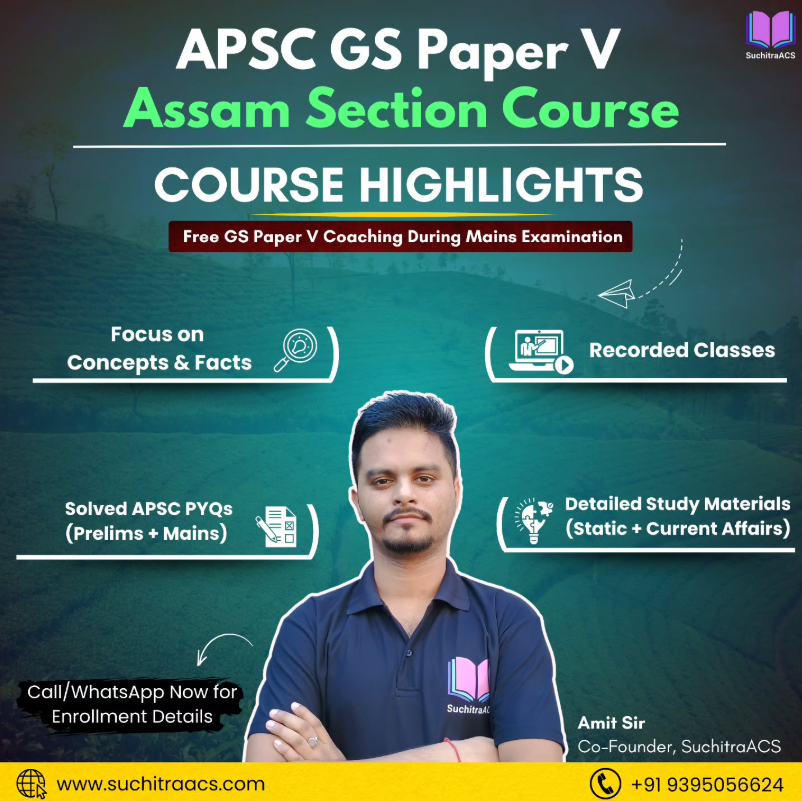

🔔 Join Our WhatsApp Study Group!
For exclusive access to premium quality content, including study materials, current affairs, MCQs, and model answers for APSC CCE and other Assam competitive exams.
Click here to join: SuchitraACS Study WhatsApp Group
📚 Want to know more about SuchitraACS’s most affordable courses?
Click here to know more: SuchitraACS Courses for APSC CCE and Assam Competitive Examinations

